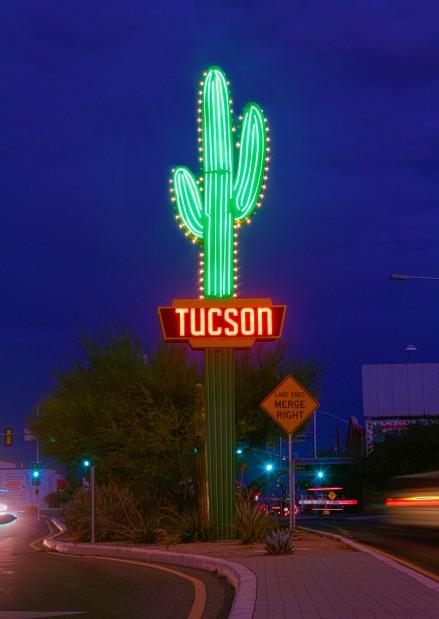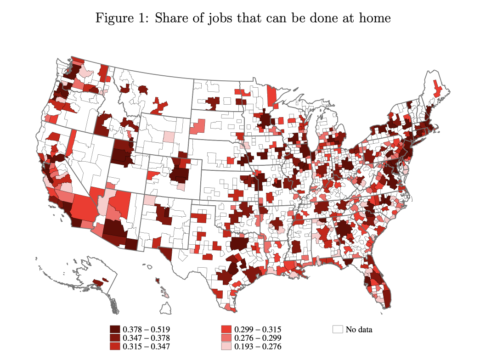Part II of “Tucson After the Coronavirus“

When I left my office on March 11, I had no idea that I wouldn’t be returning for months. It’s now been 74 days since I had a normal schedule… 74 days since I’ve shaken anyone’s hand… 74 days since I’ve swapped business cards with anyone. It’s disorienting, and I can’t believe this will remain the New Normal. All over the country, we’re seeing people getting out more, resuming some normal activities, although with a consideration of social distancing, and frequently wearing a mask. At some point — whether in weeks or months — all the stay-at-home orders will expire and people will get back to work. (Well, those whose jobs haven’t been eliminated during the Great Pause.)
Then what?
We’ll learn how to coexist with COVID-19. And we’ll put some thought into how we will deal more effectively with the next pandemic. And with the one after that. (Sadly, they’re inevitable.) Where does Tucson fit into that recovery?
Well, if you believe Moody’s Analytics, we could do very well:
Link: The 10 US Cities Best Positioned To Recover From Coronavirus
Link: Arizona Daily Star coverage of Moody’s Analytics study
To take the most extreme comparison, look at New York City:
Despite the fact that New York City has a large, skilled workforce, there are factors that will hold it back. “Riding the subway, dining in crowded restaurants and attending Broadway shows may be viewed as inherently risky for some time, consistent with the city’s status as the single-most economically exposed metro area.”
It’s been conventional wisdom for decades that if you want to succeed in financial services, you need to be in New York City. If you want to succeed in high tech, you need to be in the Bay Area. If you want to succeed in media, you need to be in Los Angeles. And so on.
I’ve rejected that conventional wisdom for a long time… certainly since I started my venture capital career in 1995 in Atlanta. Even though we shared a lunchroom in 1986, Steve Case and I have vastly different backgrounds. For years, he’s been promoting “The Rise of the Rest“… which isn’t all that different from the message of “Not the Valley” that I started pushing in Atlanta over a decade ago.
Link: Not the Valley
There have been notable technology successes outside of the major centers, but the conventional wisdom has remained unchanged: if you want to play in the major leagues, you have to be in the right ballpark. With the jolt of COVID19, knowledge workers found ourselves suddenly catapulted into an unexpected future of endless Zoom meetings, Slack channels, and wearing sweatpants seven days a week.
It’s not perfect, but it’s working. And it’s not just New York City… it’s any big city, in the U.S. or around the world.

Link: How Many Jobs Can Be Done at Home?
Even in Tucson, we’ve seen Raytheon — the archetype of a highly secure, “behind the barbed wire” defense workplace — send its engineers home to work over specialized secure networks.
Pandemics naturally thrive in large multicultural cities, where people live ‘cheek by jowl’ and [where] travel to and from other countries is a fact of international tourism and commerce.
Link: The Coming Age of Dispersion
So what happens when people stop thinking of the Big Apple as the right place to build their career, and start thinking of it as a place you might get sick and die? To misquote Frank Sinatra, “If you can make it there, you can make it anywhere else“… and you might have a better quality of life in the process.
“Before the coronavirus crisis, three of New York City’s largest commercial tenants — Barclays, JP Morgan Chase and Morgan Stanley — had tens of thousands of workers in towers across Manhattan. Now, as the city wrestles with when and how to reopen, executives at all three firms have decided that it is highly unlikely that all their workers will ever return to those buildings.”
Link: Manhattan Faces a Reckoning if Working From Home Becomes the Norm
The impact is likely to be global.
Link: How Coronavirus Could Make People Move
We’re already seeing the first impacts… both top-down and bottom-up.
Top-down:
Mark Zuckerberg is sending a strong message that his employees don’t have to be in the Bay Area anymore:
Link: Facebook will now let some employees work from anywhere, but their paychecks could get cut
(And, no, if you are making a Bay Area salary and choose to move to Tucson, you don’t keep your Bay Area salary. Yes, Zuckerberg saves money. No, that isn’t unfair. You’re choosing a better quality of life, a better home to raise kids, a shorter commute, and less daily friction, and you’re still ending up with the same discretionary cash in your pocket after paying your mortgage. What’s your problem with that? The Bay Area real estate agents have a reason to cry, but you don’t.)
Bottom-up:
Link: 2 out of 3 tech workers would leave SF permanently if they could work remotely
People aren’t stupid. If a new option emerges that lets them balance career, safety, and family in new ways, some people will analyze the tradeoffs and take advantage of the post-coronavirus opportunities.
Link: Tech Workers Consider Escaping Silicon Valley’s Sky-High Rents
So, where will they go?
I think they’ll look at the cities on this list, where Tucson ranks highly:
Link: Jump-Starting America
Why Tucson? In a pandemic-conscious world, it’s looking like density kills. Although Tucson’s sprawl may not always be beautiful, it ensures that professionals moving here can spread out with a yard and maybe a pool… things we take for granted here, but which are almost impossible in densely-packed New York or San Francisco. If they have kids — or are thinking of kids — or, like me, have grandkids — it’s a lot more attractive than an 800 square foot third-floor flat in Brooklyn with a fire escape being your only source of fresh air.
Since choosing to move to Tucson three years ago, I’ve described it to my friends and family back in Atlanta as: “Big enough to have an Apple store, but too small to have any traffic.” (To the locals rising to complain about traffic on Campbell Avenue, I invite you to visit Atlanta. Or L.A. Or Saõ Paulo. Now, sit down. You look silly.) That “Goldilocks” status looks awfully attractive to a lot of tech professionals who are thinking about getting out of their current metro area, but aren’t really interested in going off the grid in a remote mountain cabin.
So what should we be doing about it?
Recruiting! I plan to write a future post (not the next one) about recruiting talent to Tucson, but the short version is: there are talented individuals and couples who are considering, right now, where to move. Most of them aren’t considering Tucson. Even those for whom Tucson would be a perfect fit.
They haven’t seriously considered Tucson. They don’t even think about Tucson. If they’re asked about Tucson, they come back with… “Um. Hot? Really hot? And retirees. Lots of golf!”
If they’re on the East Coast, they’re thinking about Nashville or Tampa. If they’re on the West Coast, they’re thinking about Spokane or Boise. And everyone is thinking about Austin. We need to get on their mental short list.
And the way to do that is not just by topping the lists at Site Selection magazine (that’s necessary but not sufficient). These decisions are being made by individuals and couples, at crowded kitchen tables, trying to clear enough space to run a Zoom call while the kid chases the cat. We need to be targeting them there, through the channels they are consuming already.
Quickly. Better is the enemy of good enough, and other municipalities are going to be targeting these same people. The pandemic has given us an unprecedented window where individuals can relocate without changing jobs. Let’s get the word out that Tucson is a great place to balance career, safety, and lifestyle.
Part III: Nearshoring after the Pandemic
Main image credit: David Sanders, Tucson Daily Star